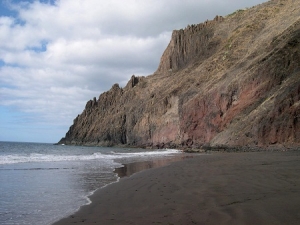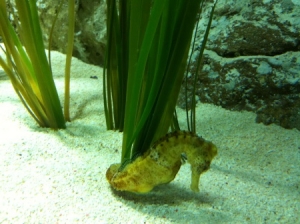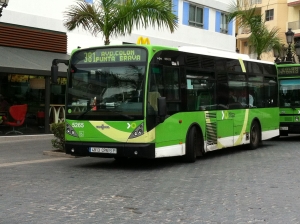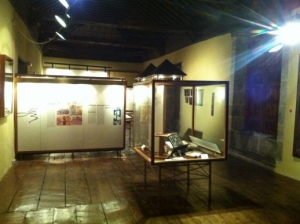Items filtered by date: May 2024
History of San Cristóbal de La Laguna Tenerife
The town of San Cristóbal de La Laguna on Tenerife in the Canary Islands was founded in 1497 by Alonso Fernández de Lugo, and gets its name from the shallow lake that was there and was subsequently drained in 1837.
The town has two historical centres, the original upper town (Villa de Arriba) of 1497, and the lower town (Villa de Abajo) of 1502. These areas were laid out according to philosophical principles of the time, having open spaces and wide streets. There are buildings dating back to the 16th century and it was the first non fortified colonial Spanish town, whose layout was copied by many colonial towns in the Americas.
The original inhabitants where nearly all soldiers and they did not get allocated plots of land to build on. Instead the area was considered to be public land on which any one could build. This resulted in haphazard construction around the church of La Concepción.
 La Laguna Tenerife Villa de Arriba 1910
La Laguna Tenerife Villa de Arriba 1910
A town plan was created in 1502 based on Leonardo da Vinci's map of Imola. Wide streets were created linking open spaces for the public, forming a grid layout on which smaller streets were later superimposed. This resulted in the rapid expansion of the Lower Town that attracted the ruling classes and monastic communities and had more than 1000 inhabitants by 1515.
 La Laguna was based on Leonardo da Vinci's map of Imola
La Laguna was based on Leonardo da Vinci's map of Imola
In 1521 a piped water supply was installed by the town council and the first public buildings were built in 1525. The town was granted official urban status in 1531. By 1555 the town’s population had risen to 6000, the largest in Canary Islands at that time, and due to the risk of fire the town council ruled that any houses made of straw must be demolished.
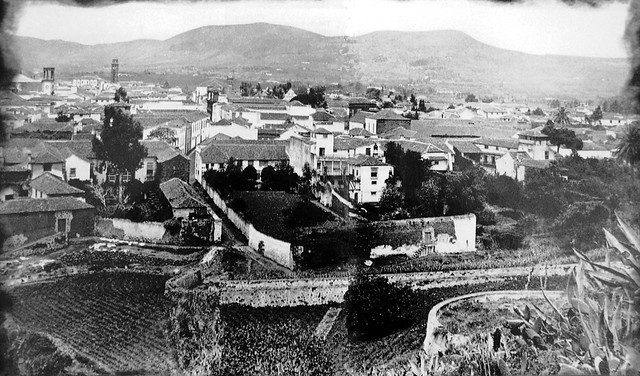 La Laguna desde San Roque Tenerife 1902
La Laguna desde San Roque Tenerife 1902
San Cristóbal remained the main commercial, political and religious centre during the 17th and 18th centuries, and this prosperity is reflected by the building from the period that still remain. But over time the economic, political and religious centre was slowly transferred to Santa Cruz and San Cristóbal went into decline.
The town recovered some of its role during the 20th century mostly due to the prestige of its university.
Las Gaviotas Beach
Las Gaviotas beach is situated north of Santa Cruz de Tenerife, 1km from the beach of La Teresitas, although it is 6 km by road. The beach is a small black sand beach set underneath cliffs and is accessible by road only.
To get to the beach follow the TF-121 road from San Andreas towards Igueste de san Andrés. There is a road on the right sign posted ‘Las Gaviotas’, this narrow road winds down under the cliffs to a small car park at the beach.
The bus line 945 stops here, but you will have to walk down Calle las Gaviotas to get to the beach.
The beach is a popular nudist beach. It also has a drinks shack on the beach selling refreshments.
Diving in Tenerife
Tenerife is now known as a World class diving destination; with divers visiting from many different countries. There are many unexpected wonderful sights for the visiting diver to discover. Whales and Dolphins can be seen offshore. Angel sharks mate during the months of March and April, and can be spotted in shallow waters. Black Atlantic stingrays and other species of Ray will be seen on most dives, and especially in the area of Los Gigantes in the South of Tenerife.
There is a dive centre in Los Gigantes, this is the only dive centre working exclusively with the Seahorse Trust in Tenerife. Seahorses are very rare but have been seen off the coast of Los Gigantes by the Dive Centre. Octopus Cove is the home of seahorses, and during the summer months there appear to be a number of these little mystical creatures around. Usually you can only see seahorses in aquariums in places like Loro Parque in the North of Tenerife.
With very clear visibility, a warm sub-tropical climate, and an extremely large impressive collection of marine life, divers can enjoy all year round diving. The volcanic Island of Tenerife rises from the deep Atlantic Ocean floor. Divers can explore the enormous entrances of the volcanically formed caves that make up some of Tenerife's underwater wonders.
There are not lots of wrecks, but there is an intact wreck of a passenger aircraft in 30 Meters that had to ditch into the ocean after encountering difficulties on take-off. There are some ship wrecks around the coast line and these are often visited by large pelagic fish.
Below are a few examples of dive sites around Tenerife, although there are many more to choose from.
Playa Paraisso offers most certified divers the opportunity to see a variety of Rays, and an old anchor which has been left behind from a ship. Atlantic, Bull, and Eagle rays can be seen on this dive.
There is a Canarian fishing village on the South West coast of Tenerife, called El Puertito. The site has been cleared of sea urchins and rubbish, and Greenback Turtles were introduced to the site. This project was successful, and later on the turtles had babies. This is an interesting dive not to be missed. The turtles are very friendly, and will come over to see the divers.
In the South of Tenerife, is Palm Mar Cave. This is a boat dive with a maximum depth of 32 Meters. A statue of Virgin Del Carmen can be seen on this dive. If you head towards the cave, the rock walls of the cave are stunning. You cannot enter the cave as it is not permitted, however you will see Moray Eels and Tiger Moray Eels around the entrance to the cave. It is common for a Ray or two to appear gliding across the sand.
Puerto de la Cruz Night Life Review
Puerto de la Cruz night life centres around the cafés and restaurants of the various districts of Puerto de la Cruz. Some of the restaurants on the sea front in the new town have live entertainment in the form of singers with electric pianos, Spanish dancers etc. The promenade and old town of Puerto de la Cruz are thronging with people at night, and there are many street entertainers and African street traders selling their wares.
Arona Summer Festival Starts Today
The second Arona Summer Festival starts today at the Olympic Stadium, Playa de las Americas. It follows on from last year successful event starting at 18:00.
The event brings dance music from around the world as well as from the Canary Islands from 15 different artists.
There will be music from Jamaican artist Sean Paul, Australian Twins ‘Nervo’ and the brothers Dimitri Vegas and Like Mike.
Titsa Surcharge up to Two Euros at Airports on Tourists
The Council of Tenerife have applied a surcharge to the Titsa bus services going to ether of Tenerife’s two airports effective from the 28th July. The extra charge being applied is of one or two euros depending on the length of the journey. Journeys that are less than 33km will have a one euro charge added on to the original fare, and those travelling more than 33km will have two euros added to the fare.
The surcharge is only chargeable for passengers traveling to the airports, and not to those passengers that are on route to different destinations but are on busses passing through the airport. So in effect you are paying leave or reach the airport, and is directed at tourists visiting Tenerife. This is in addition to the 10% increase in bus fares overall. The routes affected are 102, 108 at Tenerife north airport, and 111 and 343 at Tenerife south airport.
The first surcharges to be applied to Titsa bus services was added to the routes 342 and 348 to Teide National Park, you can only pay in cash on these two routes, stopping the use of special discounts on these routes. This surcharge is also targeted at tourists and not residents, being that it is on a tourist route up to Teide.
The Ghost of Catherine in La Laguna
In the Town of La Laguna is the Museum of History and Anthropology of Tenerife. This is situated in the “Casa Lercaro“, and was once a fine mansion. Back in November 2003 a Spanish newspaper ran a story about a ghost in the museum. The staff wanted to remain anonymous when talking about the ghost, as they were frightened of losing their jobs. Tenerife does not like to promote its historic buildings with ghosts. La Laguna Council want to keep quiet about this young lady Catherine, or Catalina in Spanish, who they say haunts the museum.
The 16th century house in San Augustine Street was owned by the wealthy Lercaro family. Catalina’s father, Antonio Lercaro, forced her to marry an older man. On the day of the wedding Catalina threw herself down a well at the back of the mansion. She was so unhappy about the marriage, and felt that there was no other way out. This made her take her own life.
The story goes that her remains are hidden in one of the rooms in the house. The church would not allow Catalina’s body to be buried in the cemetery because she had committed suicide. The well was boarded up, and the family moved away to La Orotava.
A young woman has reportedly been seen in the Museum, and mysterious footsteps have been heard. The forgotten Catalina haunts this museum in La Laguna.

El Medano 'Sensations' Food Festival Triumphs Again
El Medano successfully hosted the event “Sensations, A Flavour of Summer “on Friday night. Over thirty restaurants and bars from the town, and wineries from the island, offered local food in the form of tapas and Canarian wine for one or two euros, to thousands of people who gathered in the tourist resort. In the morning farmers had exhibited products that grow in the municipality. The event was organised to promote to the food and local products of the area by the Local Development Agency, and the Association of Businessmen and Merchants of El Medano.
Tenerife Drought Continues
With the continuing drought on Tenerife, the councillor for water on Tenerife, Jesus Morales, has stressed the need for citizens to make responsible use and avoid excessive use of water. He has emphasised that saving just a few litres a day will make a difference in the long run to water supplies.
Tenerife is currently in a drought situation that is mainly affecting agriculture as priority is given to domestic supply which is not under threat. Tenerife gets 84% of its water supply from underground sources and therefore it has been assured that water for domestic, tourist and industrial uses are safe.
Jesus Morales has pointed out that, in addition to the information campaign, steps had been taken such as the use of portable desalination plants, identification of wells capable of increasing production of water and transfer of water between different areas of the island.
Ryanair to Fly to Tenerife North from Spain
Ryanair has announced it will open two new routes to Tenerife North (Los Rodeos) airport from 7th November. The routes are from Barcelona and Madrid in mainland Spain, and the company expects to carry 300 000 passengers per year on these new routes and create 300 new jobs at the airport.
Flights between Tenerife North and Barcelona will be on Monday, Wednesday, Friday and Sunday at 11:55am, and the flights to Madrid will be daily at 12:25pm.
You can by discounted tickets until midnight 7th August 2012 from Ryanair’s website.


